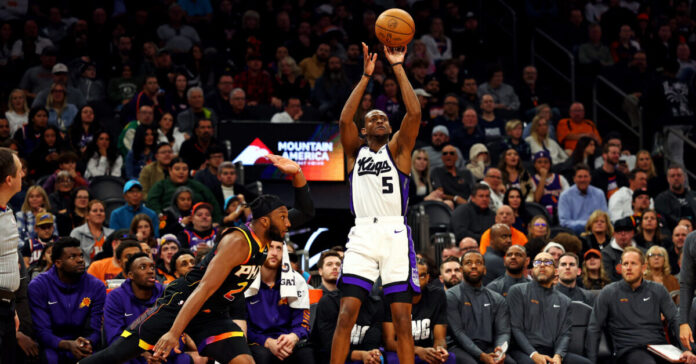On Tuesday evening, the Sacramento Kings experienced one of their most embarrassing collapses in franchise history. After dominating the Phoenix Suns for the first three-and-a-half quarters, the Kings squandered possession after possession, failed to play defense, and allowed the Suns to work their way back into what should have been a blowout victory on the road for Sacramento, with the final result being a two-point Phoenix victory.
Single game collapses aren’t necessarily season-defining, nor should they lead to panic moves by the front office of a team currently sporting a 23-17 record (although a move or two certainly is in order), but Tuesday night’s blown lead did help to define a concerning trend for Sacramento this season. Opposing teams have realized that late game change-ups, whether they be a zone defense or playing Kevin Durant at the five or switching a big defender onto De’Aaron Fox or a dozen other other small shifts, throw the Kings into a tizzy, resulting in hero ball, bad shots, live-ball turnovers, and general chaos.
The King don’t handle change well.
When those shifts occur, and a game gets close in the closing minutes, Mike Brown deploys one strategy and one strategy only: let the guards chuck. Outside of De’Aaron Fox and Malik Monk, every single regular closer for the Kings sees their average usage rate decrease in clutch time, with Domantas Sabonis and Keegan Murray feeling the most dramatic effects.
| Player | Avg. Usage | Clutch usage | Differential |
| De’Aaron Fox | 30.7% | 38.2% | 7.5% |
| Malik Monk | 23.8% | 26.2% | 2.4% |
| Domantas Sabonis | 22.3% | 15.8% | -6.5% |
| Keegan Murray | 18.7% | 12.1% | -6.6% |
| Kevin Huerter | 17.5% | 15.7% | -1.8% |
| Harrison Barnes | 13.3% | 9.9% | -3.4% |
To be fair to Mike Brown, this same strategy worked wonders for the Kings last year, as there was a reason De’Aaron Fox won the Clutch Player of the Year Award. In fact, Fox’s usage rate was even higher, a ridiculous 42.8%, but he hit shot after shot after shot – something not seen in Sacramento this season.
When a player’s field goal percentage dips as dramatically as Fox’s has, from 52.9% last season to 39.6% this year, some of those struggles can be attributed to nothing more than simply missing shots, but a larger theme seems to be at play. When opposing coaches know that Fox is going to be one of only two players with the ball, and they’ve had an entire offseason to work up strategies for that exact situation, shots are going to be tougher to find and tougher to hit. Add in a dramatic shift in shot selection, and Fox’s lack of clutch success begins to make a little more sense.
In 2022-2023, 16% of De’Aaron’s clutch shots came from behind the three-point line, and he made 32% of those attempts. This year, a whopping 27% of his shots are three-pointers, and he’s 0 for 13 in those situations. He’s getting to the rim less often, attempting fewer mid-range jumpers, and missing the three-pointers he refused to settle for last season. In a similar, albeit less dramatic dip, Malik Monk has also struggled with his shot in clutch minutes. Last year, he made 52.6% of his field goals and a bonkers 43.8% of his three-pointers. This season, he’s dipped to 47.1% and 27.8% respectively.
Opposing teams know that if they can trip the Kings up late, Malik Monk and De’Aaron Fox are taking over, no matter the result. Domantas Sabonis won’t shoot, and Keegan Murray, Kevin Huerter, and Harrison Barnes aren’t allowed to shoot, allowing defenders to focus the vast majority of their attention on Sacramento’s two guards and no one else.
Until the Kings can demonstrate an ability to adapt to shifting strategies, and until they can learn to remain calm and execute their every-game offense in close-game situations, they’ll continue to struggle as they did in Tuesday night’s loss. Hero ball simply isn’t a winning strategy, even if it worked in the past.



















